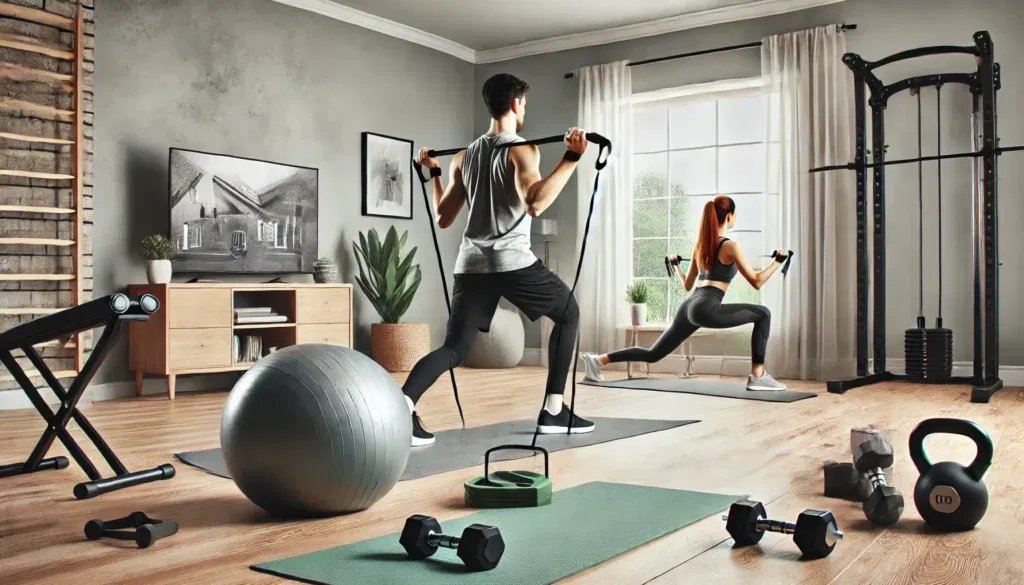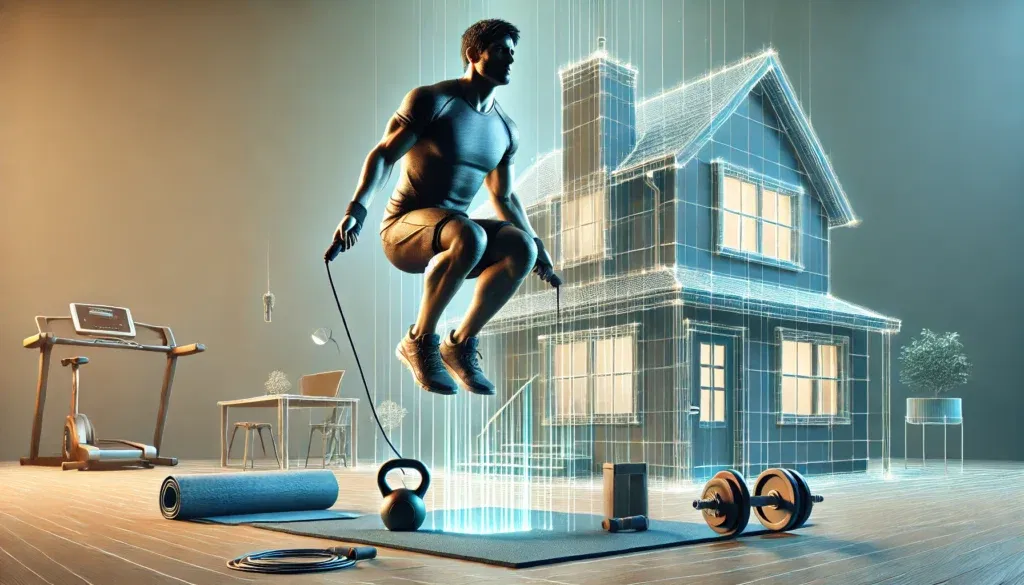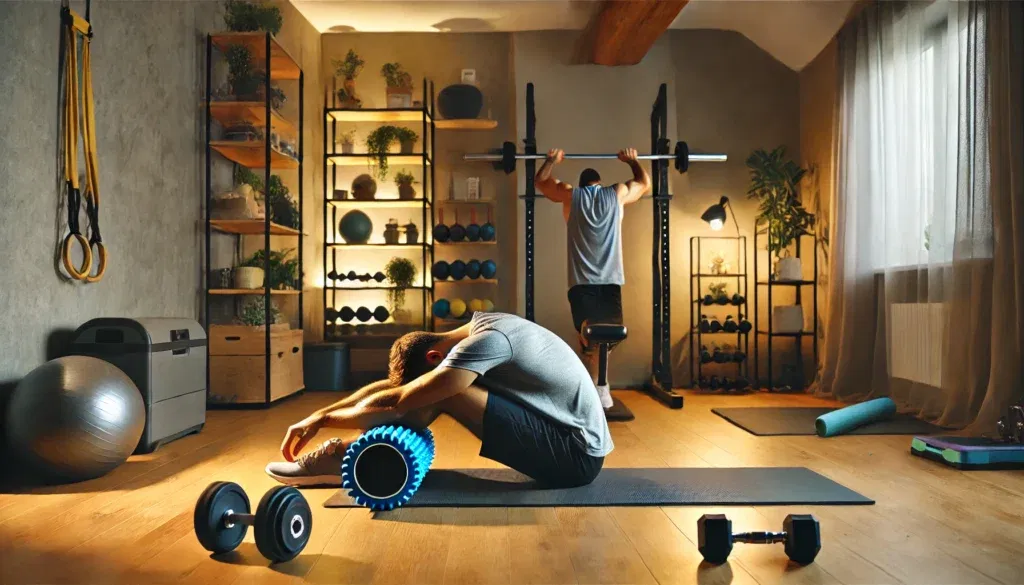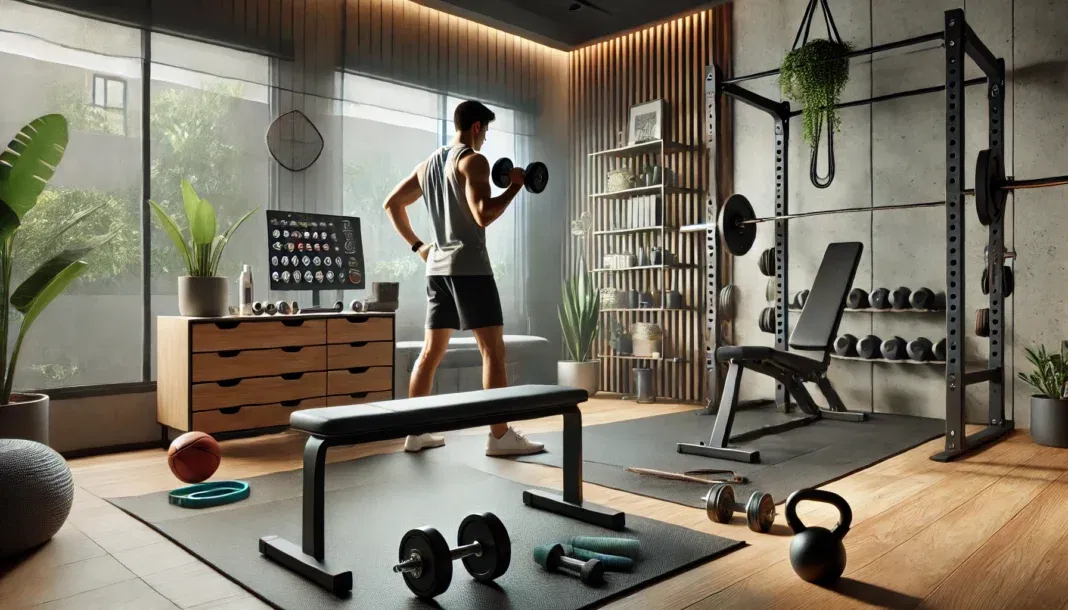Introduction: Unlocking the Potential of Home Gym Workouts
The modern fitness landscape has evolved dramatically, with home gym exercises becoming an essential component of a well-rounded training regimen. With the growing accessibility of home gym workout equipment, individuals can achieve strength and endurance improvements without stepping foot in a commercial gym. Whether you are a beginner looking to establish foundational fitness habits or an advanced athlete refining your performance, structured home gym workouts provide unparalleled flexibility and convenience.
You may also like: The Ultimate Bodyweight Workout Routine for Full-Body Strength and Performance
This guide explores how to optimize home gym exercises for maximum results by leveraging scientifically backed techniques, effective workout programming, and strategies tailored for progressive overload. A well-designed home gym workout ensures that every session contributes to long-term improvements in muscle growth, cardiovascular endurance, and functional strength. By integrating intelligent movement patterns and periodization, you can build a fitness routine that enhances both performance and longevity.
Principles of Effective Home Gym Exercises
To maximize the benefits of home gym exercises, it is essential to understand key training principles that govern strength and endurance development. Progressive overload is the foundation of any effective home gym workout, requiring gradual increases in resistance, volume, or intensity to drive adaptation. Without incremental increases in training stimuli, the body reaches a plateau, limiting potential gains in muscle size and strength.
Another critical factor is exercise selection, as different movements target various muscle groups and energy systems. Compound movements, such as squats, deadlifts, and presses, recruit multiple muscles simultaneously, making them the cornerstone of efficient home gym workouts. Isolation exercises, on the other hand, allow for targeted development and correction of muscular imbalances. By incorporating both compound and isolation movements into a balanced training program, individuals can enhance overall functional fitness while preventing injury.
Designing a Strength-Focused Home Gym Workout
Strength training in a home gym environment requires a strategic approach to exercise selection, rep schemes, and progression models. A well-structured home gym workout for strength should prioritize multi-joint movements that stimulate large muscle groups and promote neuromuscular efficiency.
For instance, utilizing resistance bands, free weights, or bodyweight exercises can provide sufficient mechanical tension to drive hypertrophy and strength gains. Progressive overload can be achieved through increased resistance, higher repetition ranges, or more challenging variations of exercises. Implementing eccentric loading, time-under-tension techniques, and isometric holds can further amplify the effectiveness of strength-based home gym exercises.
Enhancing Endurance with Home Gym Exercises
Cardiovascular endurance is a vital aspect of overall fitness that can be effectively trained within a home gym setting. High-intensity interval training (HIIT) is a time-efficient approach that blends strength movements with short bursts of maximal effort cardio. This method increases aerobic capacity while simultaneously improving muscular endurance.
Endurance-focused home gym workouts can include circuit training, tempo-based running on a treadmill, or jump rope intervals. By manipulating rest periods and work durations, individuals can tailor their training to improve both aerobic and anaerobic energy systems. Additionally, incorporating unilateral movements—such as lunges, step-ups, and single-arm presses—enhances stability and coordination while reinforcing endurance-based adaptations.

Progressive Overload and Adaptation Strategies
Progressive overload ensures that home gym workouts continue driving results over time. Adjusting variables such as load, rep range, tempo, and rest periods creates a stimulus that forces muscles and cardiovascular systems to adapt.
Tracking performance metrics, including volume progression, bar speed, and heart rate recovery, allows individuals to fine-tune their programming for continued improvements. Advanced training strategies, such as undulating periodization and autoregulation, can be integrated to accommodate fluctuations in recovery and performance. These principles ensure that home gym exercises remain challenging yet sustainable, promoting long-term fitness gains without risk of overtraining.
Recovery and Injury Prevention in Home Gym Workouts
Recovery is an often-overlooked component of a successful home gym workout regimen. Without adequate rest and tissue repair, performance deteriorates, and the risk of injury increases. Active recovery techniques, such as mobility drills, foam rolling, and yoga, complement home gym exercises by improving flexibility and circulation.
Proper warm-ups and cooldowns further enhance movement efficiency and reduce muscle soreness. Implementing deload weeks—where overall training intensity is reduced—prevents central nervous system fatigue and maintains long-term consistency. Understanding the interplay between intensity and recovery optimizes performance and allows for sustainable progress in home gym workouts.

Frequently Asked Questions (FAQ) on Home Gym Exercises and Workouts
1. How can I make home gym exercises as effective as gym workouts? Home gym exercises can be just as effective as traditional gym workouts if approached strategically. The key is to focus on progressive overload by increasing resistance, repetitions, or time under tension over time. Investing in versatile equipment, such as adjustable dumbbells, resistance bands, and kettlebells, can help replicate the resistance and variety available in a commercial gym. Additionally, incorporating compound movements like squats, push-ups, and pull-ups ensures maximal muscle activation. Structured programming, which includes periodization and recovery strategies, can help sustain long-term progress in home gym workouts.
2. What are the best ways to build endurance with a home gym workout? Building endurance through home gym exercises requires a combination of cardiovascular and strength training. High-intensity interval training (HIIT) is one of the most efficient methods, as it combines short bursts of intense effort with brief recovery periods. Circuit training, where multiple exercises are performed back-to-back with minimal rest, also improves muscular and cardiovascular endurance. Using bodyweight exercises like burpees, jump squats, and mountain climbers can enhance stamina without requiring additional equipment. Gradually increasing the duration and intensity of sessions ensures continuous improvement in endurance over time.
3. How do I avoid hitting a plateau with my home gym workout? Avoiding plateaus in home gym exercises involves continuously challenging the body through variation and progression. Changing exercise selection, adjusting rep ranges, and incorporating advanced techniques such as drop sets or supersets can reignite muscle adaptation. Additionally, experimenting with different workout splits—such as full-body training versus muscle group isolation—keeps the training stimulus fresh. Recovery also plays a crucial role, as inadequate rest can lead to stagnation; prioritizing sleep, proper nutrition, and mobility work supports ongoing progress. Tracking performance metrics, such as personal bests or volume progression, ensures continued motivation and growth.
4. What is the ideal frequency for a home gym workout? The ideal frequency of home gym workouts depends on individual fitness goals and recovery capacity. For general fitness, three to four sessions per week that include a mix of strength and endurance exercises are effective. Those focusing on muscle hypertrophy might benefit from four to five sessions, targeting different muscle groups throughout the week. Advanced trainees aiming for peak performance can train up to six days per week but must ensure proper recovery strategies. Regardless of frequency, consistency and variation in training routines ensure sustainable results over time. Listening to the body and allowing rest days when needed prevents overtraining and potential injuries.
5. How do I create an effective home gym workout routine with limited equipment? Maximizing home gym exercises with limited equipment requires creativity and strategic programming. Resistance bands, bodyweight movements, and household items like water jugs can add variety and challenge to workouts. Focusing on unilateral movements, such as single-leg squats or single-arm presses, increases muscle engagement and balance. Implementing tempo changes—such as slowing down the eccentric phase—creates additional resistance without needing heavy weights. A combination of compound and isolation exercises ensures a well-rounded routine, even with minimal gear.
6. How can I incorporate functional training into my home gym workouts? Functional training enhances real-world movement patterns, improving coordination, balance, and athletic performance. Home gym exercises like kettlebell swings, Turkish get-ups, and resistance band chops develop core strength and stability. Incorporating unilateral movements, such as lunges and single-arm carries, enhances proprioception and balance. Suspension trainers, if available, provide an excellent way to train using body weight while improving range of motion. Regularly including dynamic movements mimicking daily activities strengthens the body holistically.
7. How can I stay motivated to maintain a consistent home gym workout routine? Maintaining motivation for home gym exercises requires setting clear goals, tracking progress, and maintaining variety. Establishing a dedicated workout space enhances consistency by creating a designated fitness environment. Using training apps or online communities provides accountability and structured programming. Incorporating challenges, such as setting personal records or participating in virtual fitness events, adds excitement and purpose. Additionally, varying routines every few weeks prevents monotony and keeps the experience engaging.
8. What are some advanced techniques to enhance my home gym exercises? Advanced training techniques can elevate the effectiveness of home gym workouts by intensifying training stimulus. Methods such as eccentric training—slowing down the lowering phase—build strength without increasing weight. Drop sets, where weight is reduced after muscle failure, maximize muscle fatigue and growth. Isometric holds, such as pausing at the bottom of a squat, improve muscular endurance and stability. Combining plyometric movements, such as explosive push-ups, with strength exercises enhances power development. Utilizing these techniques adds variety and drives continued adaptation.
9. How do I balance strength and endurance training in my home gym workouts? Balancing strength and endurance in home gym exercises requires structuring workouts with both resistance and cardiovascular elements. Alternating between strength-focused days and endurance-based sessions ensures comprehensive fitness development. Hybrid workouts, which integrate both resistance and cardio in a single session, optimize efficiency. Prioritizing compound movements, such as deadlifts followed by sprints, maximizes overall conditioning. Adjusting work-to-rest ratios, such as performing short recovery intervals, enhances endurance while maintaining muscle-building potential.
10. How can I ensure proper recovery after intense home gym workouts? Recovery is critical for maximizing the benefits of home gym exercises and preventing burnout. Prioritizing post-workout nutrition, including adequate protein intake, supports muscle repair and growth. Active recovery days, involving low-intensity movements like stretching or yoga, reduce soreness and improve mobility. Foam rolling and massage therapy help alleviate muscular tightness and enhance circulation. Adequate sleep, hydration, and managing stress levels further contribute to optimal recovery. Implementing these recovery strategies ensures sustained performance and long-term training success.

Conclusion: Mastering Home Gym Exercises for Optimal Results
Home gym exercises provide a powerful foundation for strength, endurance, and overall fitness when programmed with intention and precision. By applying fundamental training principles, varying intensity, and emphasizing recovery, individuals can construct highly effective home gym workouts that rival commercial gym training.
Whether the goal is muscle hypertrophy, improved cardiovascular capacity, or functional strength, a well-designed home gym workout fosters continuous improvement and adaptability. Through consistent application of progressive overload and structured periodization, home training environments can produce results that transcend traditional fitness models. By committing to intelligent programming, proper technique, and strategic recovery, fitness enthusiasts can achieve lasting success with home gym exercises.
strength training, fitness programming, home workout optimization, resistance training, muscle hypertrophy, endurance training, HIIT workouts, recovery techniques, periodization, mobility drills, injury prevention, home fitness, functional strength, bodyweight exercises, circuit training, progressive overload, strength and conditioning, exercise science, optimal training methods, training adaptation.
Further Reading:
Build Muscle at Home Fast: 30 Exercises and Workouts
10 Home Strength Training Exercises Without Equipment
I’m a Personal Trainer: Here’s the 5 Most Effective Exercises You Can Possibly Do at Home
Important Note: The content provided by HealthXWire is for informational purposes only and should not be construed as medical advice, diagnosis, or treatment. While we strive for accuracy, the information presented on this site may not reflect the most current research or medical guidelines. Always seek the advice of your physician or other qualified health provider with any questions you may have regarding a medical condition. HealthXWire does not endorse, recommend, or guarantee the efficacy of any products, services, or treatments mentioned on this site. Users should not disregard professional medical advice or delay seeking it because of something they have read on HealthXWire. HealthXWire is not liable for any damages, loss, or injury arising from reliance on the information provided herein.



